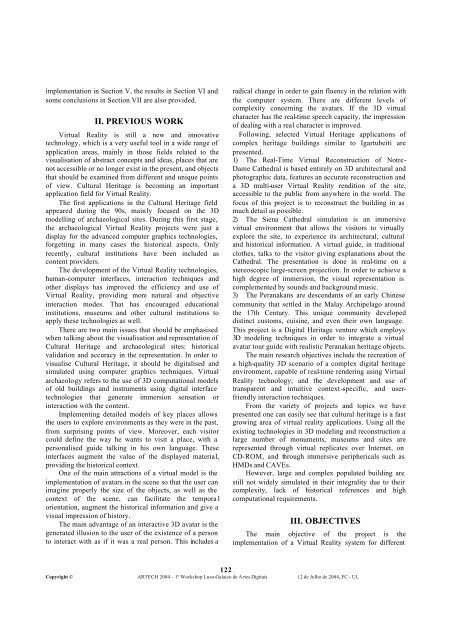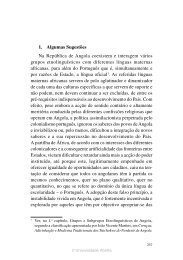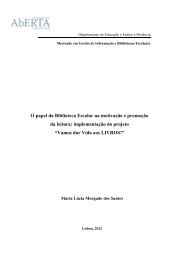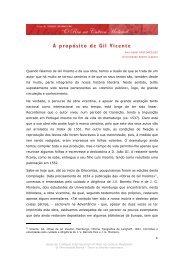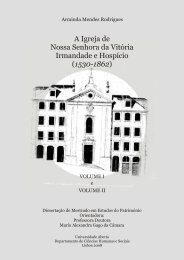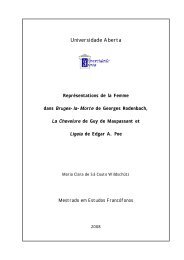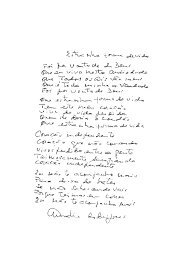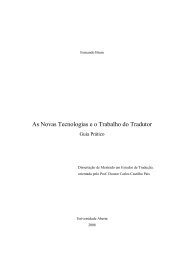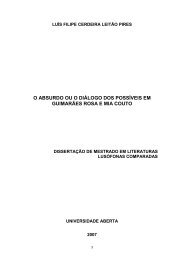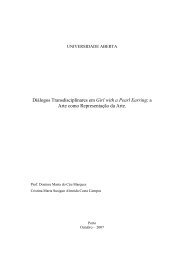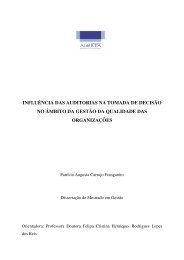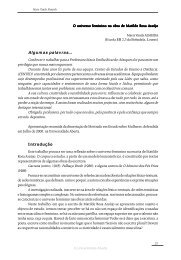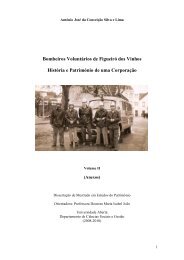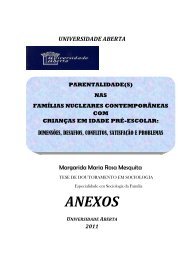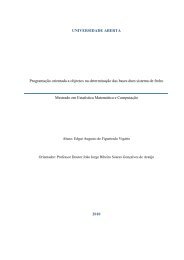NA SENDA DA IMAGEM A Representação ea Tecnologia na Arte
NA SENDA DA IMAGEM A Representação ea Tecnologia na Arte
NA SENDA DA IMAGEM A Representação ea Tecnologia na Arte
Create successful ePaper yourself
Turn your PDF publications into a flip-book with our unique Google optimized e-Paper software.
implementation in Section V, the results in Section VI and<br />
some conclusions in Section VII are also provided.<br />
II. PREVIOUS WORK<br />
Virtual R<strong>ea</strong>lity is still a new and innovative<br />
technology, which is a very useful tool in a wide range of<br />
application ar<strong>ea</strong>s, mainly in those fields related to the<br />
visualisation of abstract concepts and id<strong>ea</strong>s, places that are<br />
not accessible or no longer exist in the present, and objects<br />
that should be examined from different and unique points<br />
of view. Cultural Heritage is becoming an important<br />
application field for Virtual R<strong>ea</strong>lity.<br />
The first applications in the Cultural Heritage field<br />
app<strong>ea</strong>red during the 90s, mainly focused on the 3D<br />
modelling of archaeological sites. During this first stage,<br />
the archaeological Virtual R<strong>ea</strong>lity projects were just a<br />
display for the advanced computer graphics technologies,<br />
forgetting in many cases the historical aspects. Only<br />
recently, cultural institutions have been included as<br />
content providers.<br />
The development of the Virtual R<strong>ea</strong>lity technologies,<br />
human-computer interfaces, interaction techniques and<br />
other displays has improved the efficiency and use of<br />
Virtual R<strong>ea</strong>lity, providing more <strong>na</strong>tural and objective<br />
interaction modes. That has encouraged educatio<strong>na</strong>l<br />
institutions, museums and other cultural institutions to<br />
apply these technologies as well.<br />
There are two main issues that should be emphasised<br />
when talking about the visualisation and representation of<br />
Cultural Heritage and archaeological sites: historical<br />
validation and accuracy in the representation. In order to<br />
visualise Cultural Heritage, it should be digitalised and<br />
simulated using computer graphics techniques. Virtual<br />
archaeology refers to the use of 3D computatio<strong>na</strong>l models<br />
of old buildings and instruments using digital interface<br />
technologies that generate immersion sensation or<br />
interaction with the content.<br />
Implementing detailed models of key places allows<br />
the users to explore environments as they were in the past,<br />
from surprising points of view. Moreover, <strong>ea</strong>ch visitor<br />
could define the way he wants to visit a place, with a<br />
perso<strong>na</strong>lised guide talking in his own language. These<br />
interfaces augment the value of the displayed material,<br />
providing the historical context.<br />
One of the main attractions of a virtual model is the<br />
implementation of avatars in the scene so that the user can<br />
imagine properly the size of the objects, as well as the<br />
context of the scene, can facilitate the tempora l<br />
orientation, augment the historical information and give a<br />
visual impression of history.<br />
The main advantage of an interactive 3D avatar is the<br />
generated illusion to the user of the existence of a person<br />
to interact with as if it was a r<strong>ea</strong>l person. This includes a<br />
radical change in order to gain fluency in the relation with<br />
the computer system. There are different levels of<br />
complexity concerning the avatars. If the 3D virtual<br />
character has the r<strong>ea</strong>l-time speech capacity, the impression<br />
of d<strong>ea</strong>ling with a r<strong>ea</strong>l character is improved.<br />
Following, selected Virtual Heritage applications of<br />
complex heritage buildings similar to Igartubeiti are<br />
presented.<br />
1) The R<strong>ea</strong>l-Time Virtual Reconstruction of Notre-<br />
Dame Cathedral is based entirely on 3D architectural and<br />
photographic data, f<strong>ea</strong>tures an accurate reconstruction and<br />
a 3D multi-user Virtual R<strong>ea</strong>lity rendition of the site,<br />
accessible to the public from anywhere in the world. The<br />
focus of this project is to reconstruct the building in as<br />
much detail as possible.<br />
2) The Sie<strong>na</strong> Cathedral simulation is an immersive<br />
virtual environment that allows the visitors to virtually<br />
explore the site, to experience its architectural, cultural<br />
and historical information. A virtual guide, in traditio<strong>na</strong>l<br />
clothes, talks to the visitor giving expla<strong>na</strong>tions about the<br />
Cathedral. The presentation is done in r<strong>ea</strong>l-time on a<br />
stereoscopic large-screen projection. In order to achieve a<br />
high degree of immersion, the visual representation is<br />
complemented by sounds and background music.<br />
3) The Pera<strong>na</strong>kans are descendants of an <strong>ea</strong>rly Chinese<br />
community that settled in the Malay Archipelago around<br />
the 17th Century. This unique community developed<br />
distinct customs, cuisine, and even their own language.<br />
This project is a Digital Heritage venture which employs<br />
3D modeling techniques in order to integrate a virtual<br />
avatar tour guide with r<strong>ea</strong>listic Pera<strong>na</strong>kan heritage objects.<br />
The main res<strong>ea</strong>rch objectives include the recr<strong>ea</strong>tion of<br />
a high-quality 3D sce<strong>na</strong>rio of a complex digital heritage<br />
environment, capable of r<strong>ea</strong>l-time rendering using Virtual<br />
R<strong>ea</strong>lity technology; and the development and use of<br />
transparent and intuitive context -specific, and userfriendly<br />
interaction techniques.<br />
From the variety of projects and topics we have<br />
presented one can <strong>ea</strong>sily see that cultural heritage is a fast<br />
growing ar<strong>ea</strong> of virtual r<strong>ea</strong>lity applications. Using all the<br />
existing technologies in 3D modeling and reconstruction a<br />
large number of monuments, museums and sites are<br />
represented through virtual replicates over Internet, on<br />
CD-ROM, and through immersive periphericals such as<br />
HMDs and CAVEs.<br />
However, large and complex populated building are<br />
still not widely simulated in their integrality due to their<br />
complexity, lack of historical references and high<br />
computatio<strong>na</strong>l requirements.<br />
III. OBJECTIVES<br />
The main objective of the project is the<br />
implementation of a Virtual R<strong>ea</strong>lity system for different<br />
122<br />
Copyright © ARTECH 2004 – 1º Workshop Luso-Galaico de <strong>Arte</strong>s Digitais 12 de Julho de 2004, FC - UL


